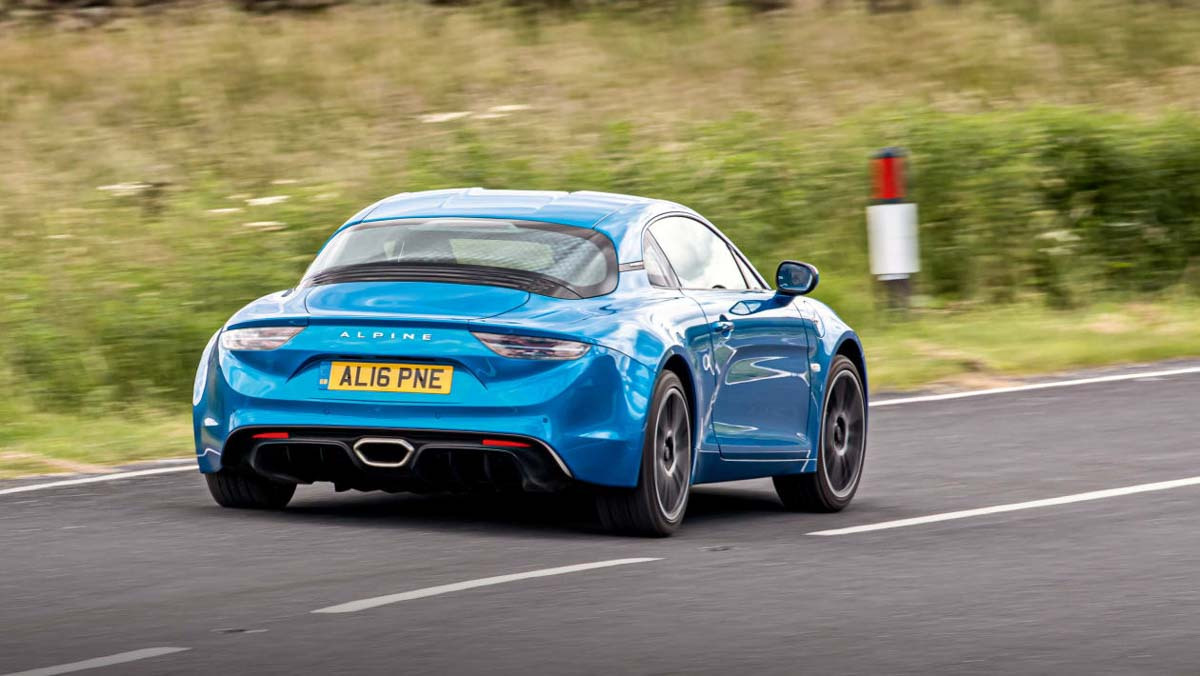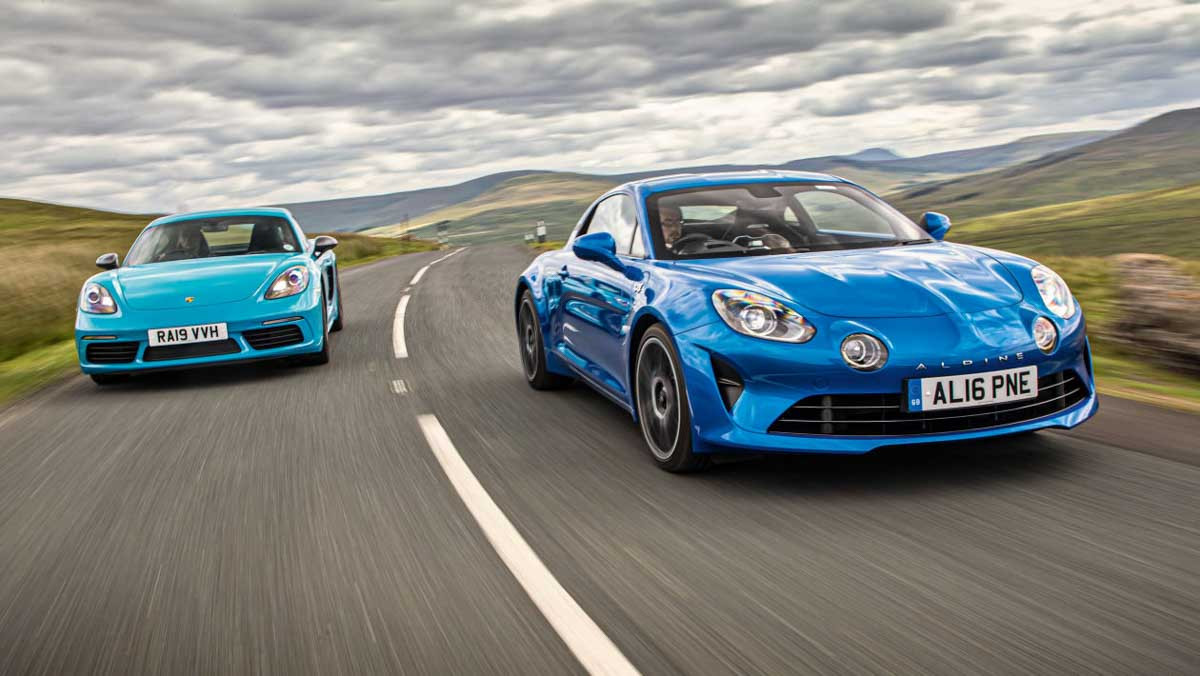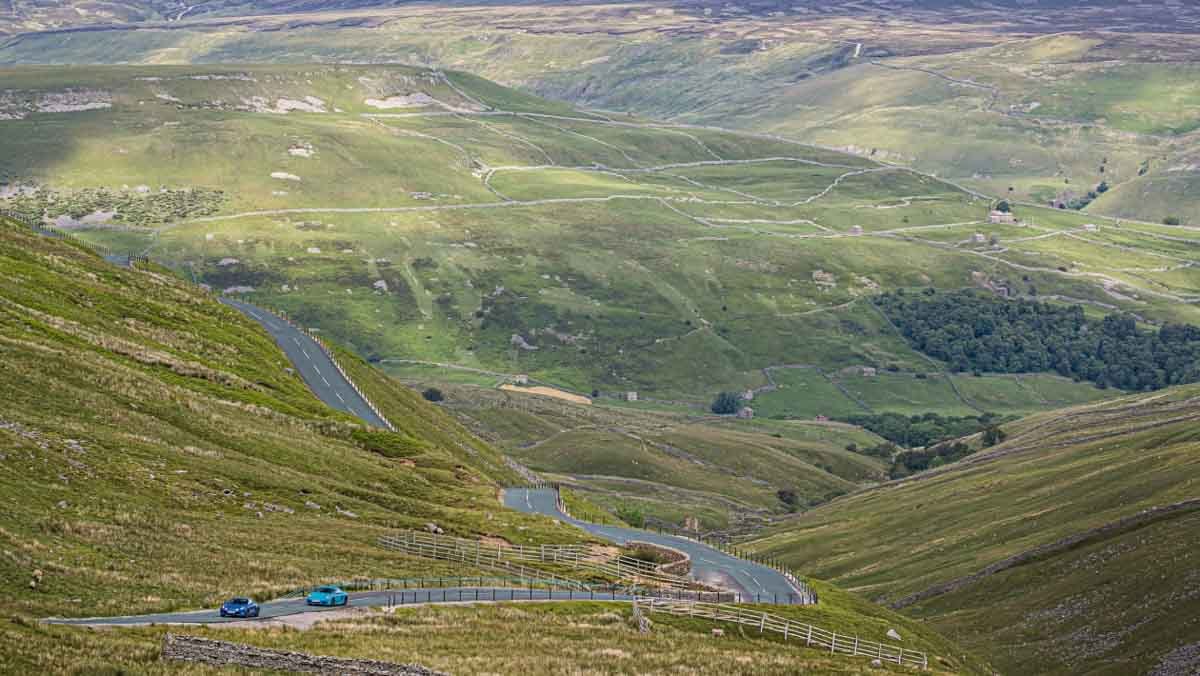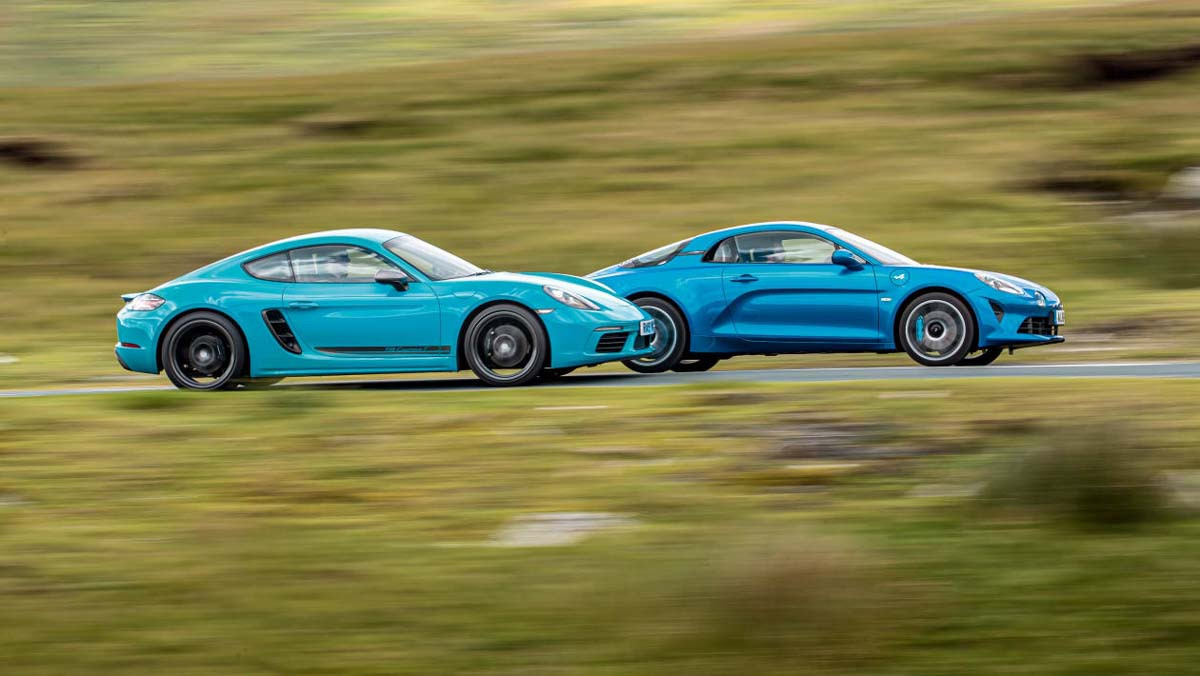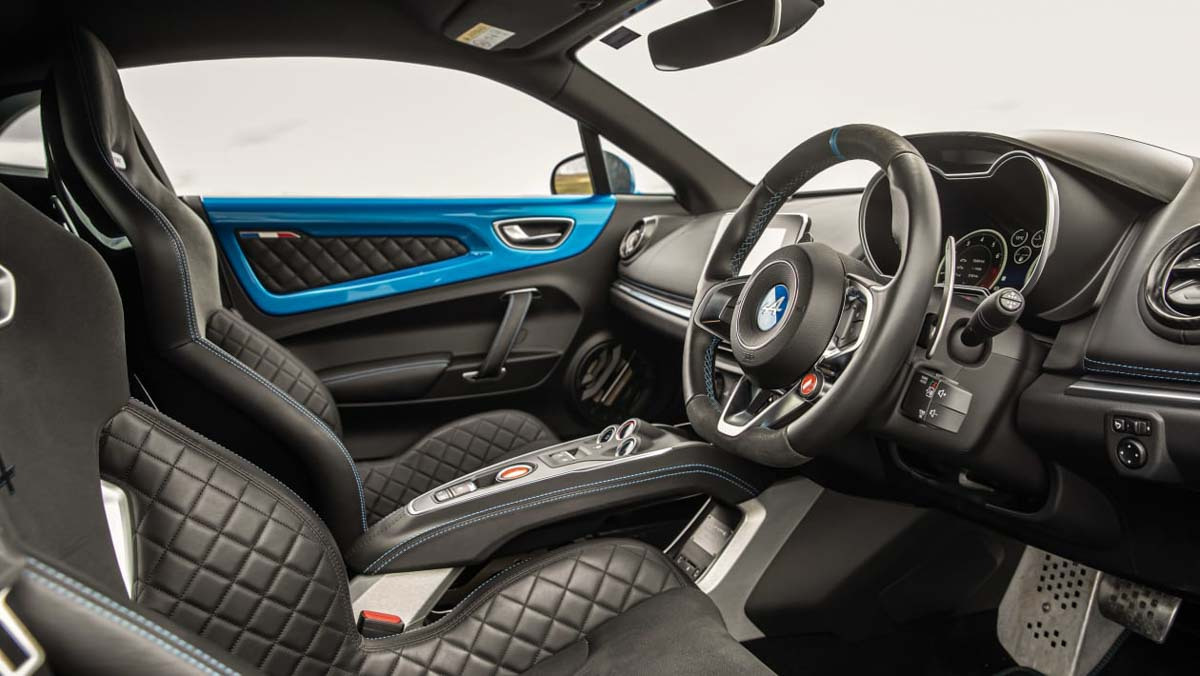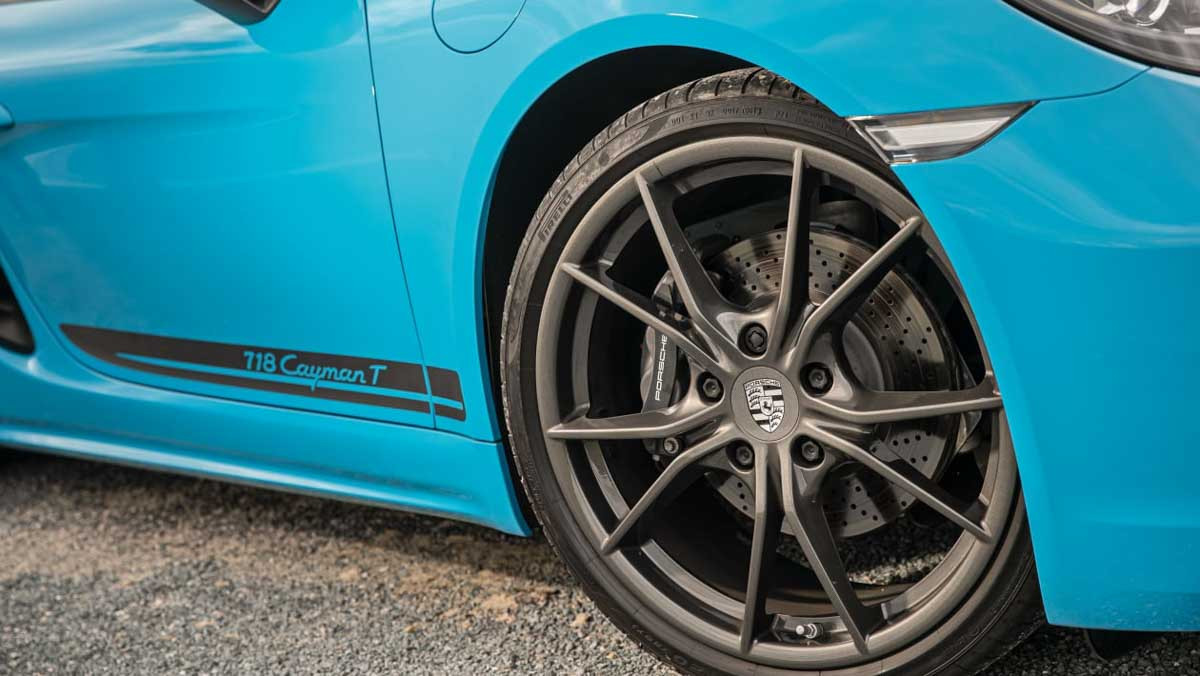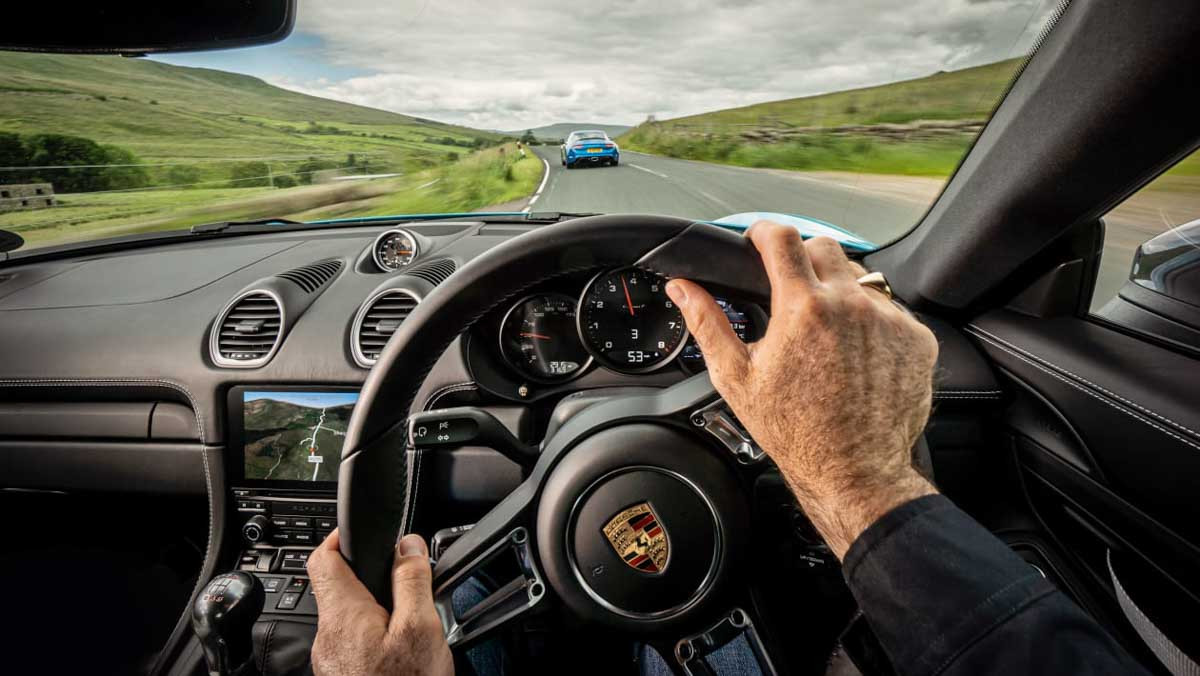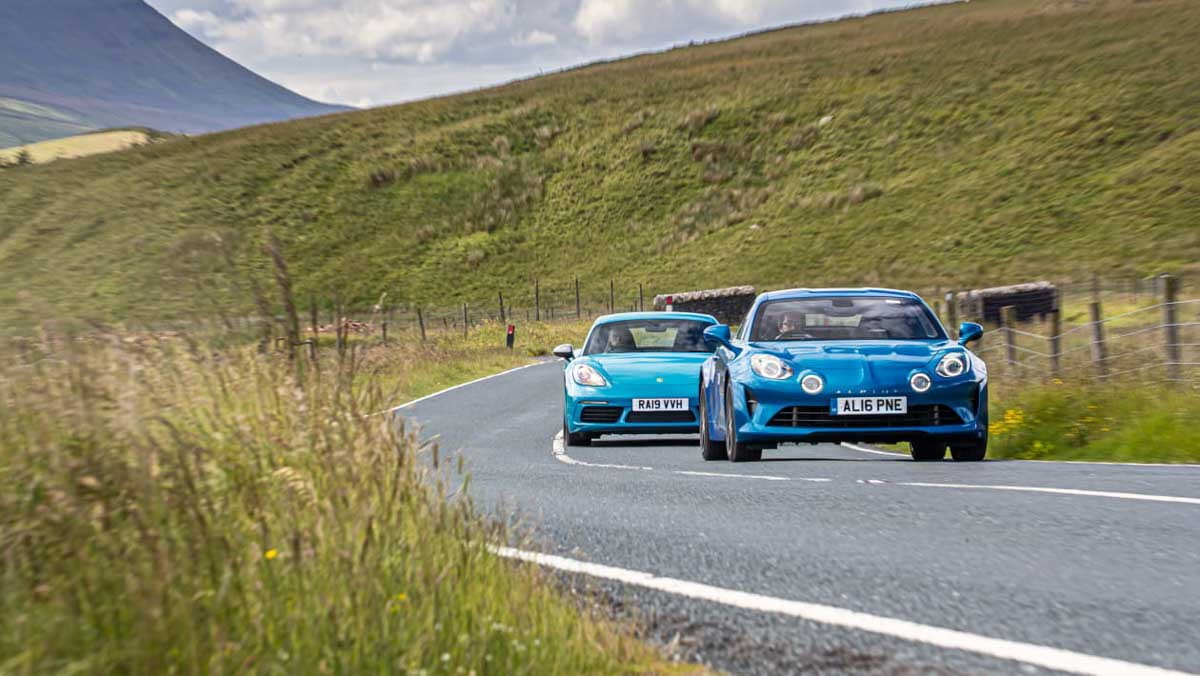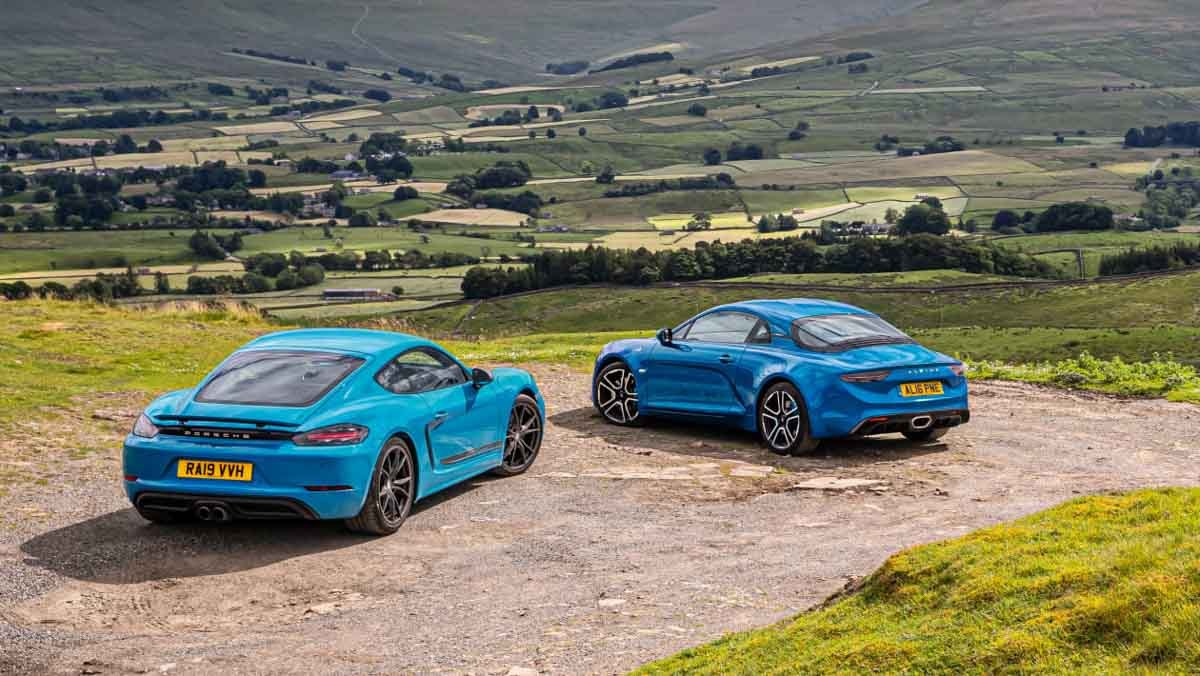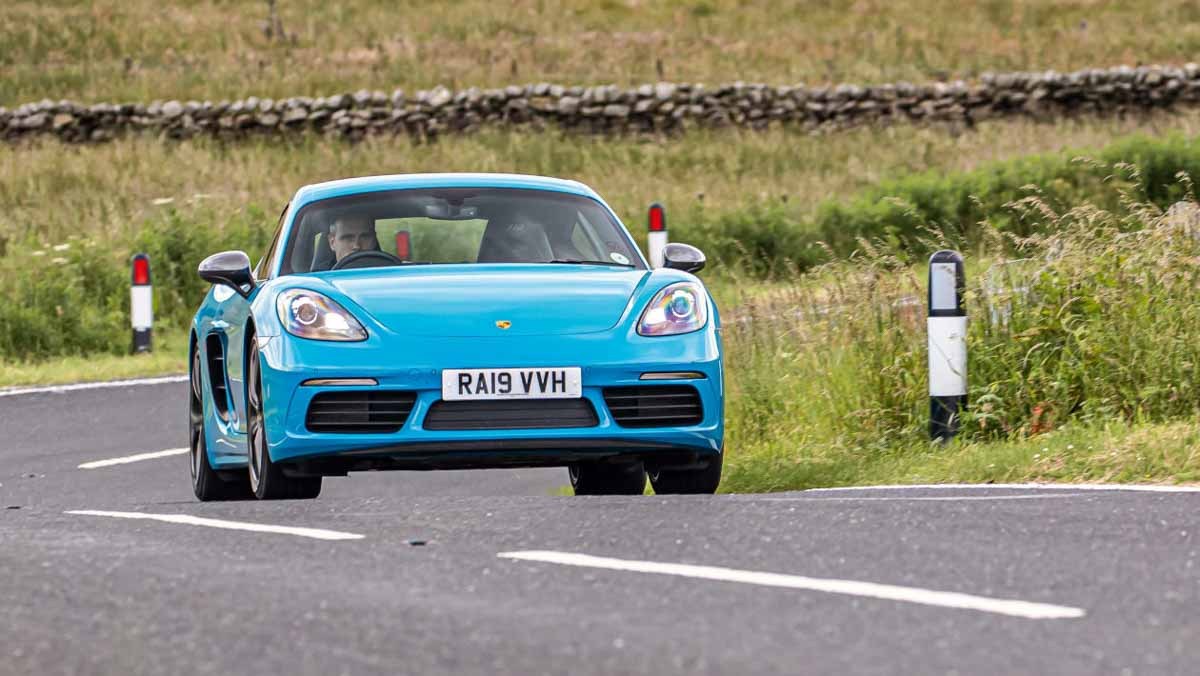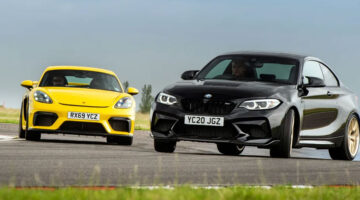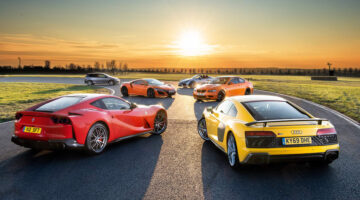T specification brings more driver focus to the entry-level Porsche 718 Cayman. But is it good enough to see off its $70k sports coupe rival, Alpine’s A110?
By rights, the Cayman T should be one of the best driver’s cars Porsche makes, perhaps even the best. Certainly for driving on the public road, at least. It definitely won’t be the fastest, the most accelerative, or the quickest around a lap, but a relatively compact mid-engined coupe from those Wunderdoktors in Stuttgart, with a back-to-basics approach aimed squarely at driving enthusiasts, an ample 296bhp moving 1350kg, and a mechanical limited-slip diff fitted as standard, and all for a relatively – by Porsche standards – keen price, surely has ‘future classic evo material’ already engraved on its rump in characteristic Porsche script?
However, as we stride into 2021, we all know that things won’t be as straightforward as all of that suggests in this Franco-Germanic encounter. The Porsche 718 has a problem, as does Porsche. That fateful decision to junk one of the brand’s genuine USPs over its competition – the silken tones and crisp responses of its hearty, naturally aspirated flat-six – remains as controversial as ever. And yet there’s no point in continuing to scribble the same old grievances ad nauseam, so let’s look forward and see instead if the T’s driver-focused ethos can claim back enough of the deficit brought about by its uncouth motor to maintain the balance of power.
It would be remiss to ignore the fact that the 718 Cayman and Alpine’s A110 have met before, in our Supertest, and that the Porsche triumphed. Isn’t it therefore a foregone conclusion? The result of that particular test was a hotly debated among the team, the outcome influenced by the circuit and data elements, and by the Porsche being represented by an ‘S’ model. A split formed between those who saw the Cayman as the faster and potentially more capable car and the Première Edition A110 as rather strong money, and those who could never conceive buying a Porsche powered by that four-cylinder engine and who loved the feel and approach of the Alpine. The arguments raged, the office reverberating to the cold, vicious thwack of handbag impacting handbag, and while both cars were awarded the same star rating, on the day, the writer gave the nod – just – to the Porsche. But with the benefit of hindsight… hmm.
> Porsche 718 Cayman review – the entry-level Porsche punches above its weight
The T, though, feels the more relevant rival. It takes its name from the entry-level 911 of the early 1970s, although that car was never marketed as a sporting or driver’s option, merely as a cheaper one, and its only link to a performance ethos is that fitting the most powerful 911 S engine into the lightest 911, the basic T, created the ultimate rallying and circuit racing 911 of the time, the so-called 911 S/T. This was a paperwork exercise, because in reality a customer would simply spec their car for motorsport use from the Porsche catalogue, but it allowed the car to compete at an advantageous weight limit. Our modern-day Cayman T is a marketing ploy, effectively providing around $12,000 of optional extras (including sports suspension, a more playful Sport setting for the stability management system within the Sport Chrono pack, torque vectoring, that mechanical LSD, active drivetrain mounts and 20-inch Carrera S wheels) for an additional $7800, and while that pushes the $72,884 T close to the price of the 345bhp Cayman S ($75,251), to upgrade the chassis and other elements of the S swells that gap once more. Looking back to that Supertest one more time, the price of that particular S began with a seven…
All of this I’m chewing on as I head northwards in my small blue capsule, slipping through the air effortlessly, lurking in the shadows cast by articulated lorries, feeling the nose wriggle this way and that as the narrow front tyres follow the ruts carved by the passing of a million heavy vehicles. It’s hard to imagine the A110 ever being weighty enough to plough its own furrow in such a brutally physical way, such is the deftness of its responses, and the pronounced sensation of mass pared back that permeates everything it does.
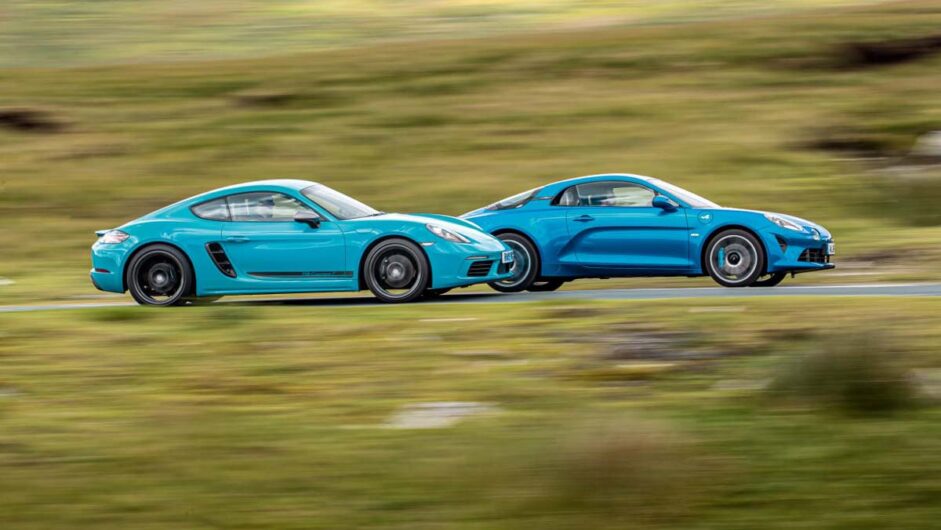
So much has already been written about the A110, so many pages in our magazine already devoted to it and what it stands for. I don’t think we should make any apologies about that, if you’ll excuse the blatant bullishness on my part, because it’s been an all-too-rare high point in an industry seemingly obsessed with power and technology on the road to self-promoted oblivion. It’s just so disappointing that cars that imbue fresh, independent thinking are largely a thing of the past, outside of those with seven-figure price tags.
The A110 is a surprisingly relaxing and frugal companion en route to North Yorkshire, and by the time I meet up with Antony Ingram in the Cayman at a garage jet wash, I’m totally sold on it. Its biggest weakness is undoubtedly the quality of its steering, which while adequate for the task, never quite imparts the feedback, progressiveness and precision that would really be the icing on this particular patisserie. The luggage space is miserly too, and we all still fantasise – as do Alpine’s engineers – that parent company Renault will find a few euros down the back of the company chaise longue and fund the option of a manual ’box. It would mean some expensive reengineering, but it’s not impossible, even at this stage, and I suspect so equipped I’d find it irresistible to sign my life away on an agreement to empty my bank account per month on one. We’d also have liked to have had the most basic, $65k Pure model here, but Renault was only able to supply a Première Edition. At $72,533, though, it is bang-on Cayman T money.
It must be said that the Porsche looks good. Purposeful. in almost equal measure means I somehow want to flog it to within an inch of its life, which in turn means the chassis comes more alive by the second. Oh yes, so this was why the Cayman S won that Supertest…
> Alpine A110 review – style, speed, agility; the French coupe delivers
I’m sitting in the T, door open and engine off, waiting for the Alpine to appear. It’s time for a pause, for some reflection. There’s a slight tinge of guilt mixed with relief – the speeds were, shall we say, on the high side, and now as the Porsche ticks away in the sturdy breeze that’s gusting off the rolling landscape it’s nice to feel car and driver are all safely in one piece. What will the French car’s riposte be, I wonder? As Antony pulls in behind me in the lay-by, it’s time to find out.
It still amazes me that two sports cars, both two-seaters and of similar performance and price, can be so different in their approach to vehicle dynamics. The Alpine isn’t just lighter on paper (by 247kg, no less), but everything it does, from the response of its steering wheel to the way the switches operate, is far more delicate to the touch. As such, it takes a while to adapt your approach, to not overdrive the Alpine and upset it in the process. You can be aggressive with it, but it’s easy to get the weight moving around in this way, which is good if you want to get the car out of shape, but less appealing when faced with an especially challenging stretch of Yorkshire mountain road.
Get it right, though, and the Alpine has its own magic. That amazingly compliant suspension set-up allows it to dance across even the worst surfaces the road throws up – sections that have painfully caused damage to the plastic underguards of some big hitters in the past. With a gentle purchase on the wheel, and an acceptance that the A110 will inevitably move around, you start to build a rapport with the car, and when it clicks, man does it really come into sharp focus, like adjusting a lens until its magnified image pings before your eye.
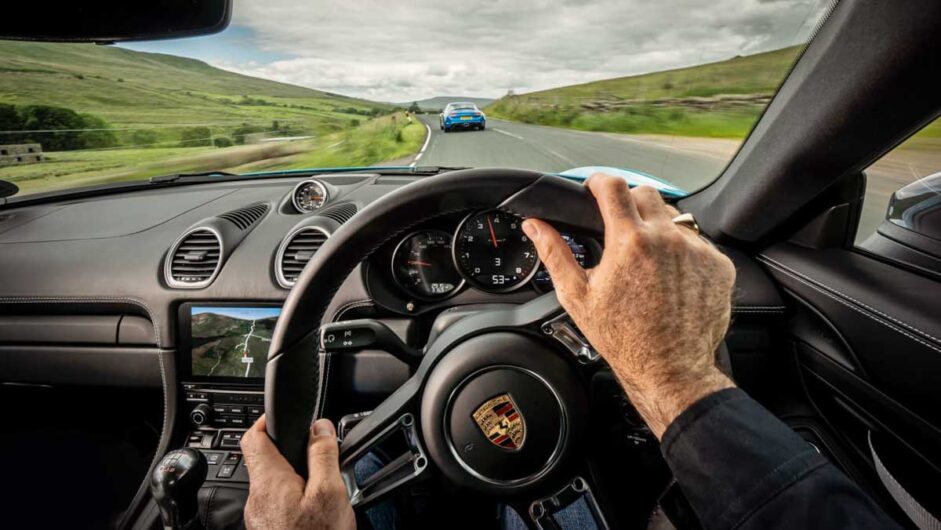
There’s something else, too: a sense of threat. Not in a bad way, mind, just that by the very nature of the Alpine’s dynamic ethos there is wriggle room for the unexpected, something that seems all but impossible in the unwavering poise of the T. I feel it directly in a medium-speed S-bend, on the cusp of third and fourth gear. Once I’ve committed to the first right-hander something in the road momentarily distracts me and I lift the throttle, not much but just enough, and a split second later I’m reminded that I’ve also disabled the ESP. I’m almost bemused momentarily by how the Alpine sits up, rotates, and then just hangs sideways, its driver rather wide-eyed and suddenly hyper alert. It’s not a dangerous moment as such, and with the necessary steering input it generates a huge grin, but it strikes me afterwards that the A110 is unusual in that if you take liberties with it then you’d better be prepared to mop it up afterwards, otherwise there will be consequences. I just can’t imagine how hard you’d have to push the T to ever feel anything as remotely risqué, in the dry at least, but the Alpine’s relationship with the road is a transient, ever-evolving type of contact.
Both these cars in their own way offer a really tangible sense of driver interaction and enjoyment, but in such diverse ways. Where they differ is in everything else. The Alpine’s four-cylinder is sharp, rorty and not without appeal, just as the Cayman remains a surprisingly practical proposition with massively more luggage space than the French car. But for me the Alpine wins this test, not just because the Cayman’s motor remains an abomination, but because the Porsche needs roads like the ones we’ve encountered here to really shine, whereas the Alpine is fun from the moment you hit the big red starter button to the time when you climb out and feel so partisan about it that you want to wrap your arms around it and give it a big hug. If every road was like the one across the Dales I’d be among the first to celebrate, but alas, it isn’t, and increasingly so. Fun and specialness at any speed are ever-more relevant qualities.
So for possibly the first time in some while the driver appeal of a Porsche wanes alongside a rival, manual ’box or not. And yet… of course the Germans weren’t going to take that one lying down: Porsche dropped a mildly detuned version of the GT4’s 4-litre naturally aspirated engine – with 400bhp, no less – plus a manual gearbox into an unsuspecting Cayman to create a current generation of GTS models, ready to take on Alpine’s range-topping A110S. Just as on the rally stages of the 1970s, this battle looks set to run and run.
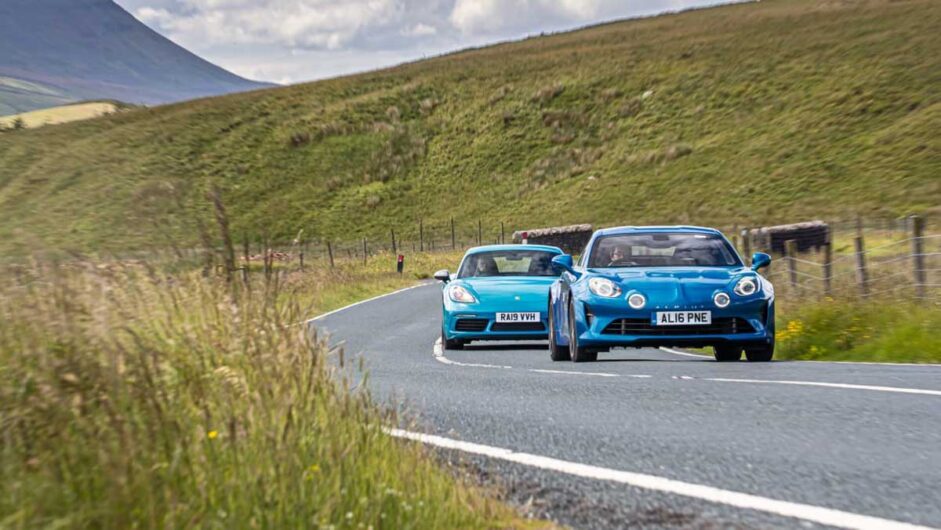
Alpine A110 Première Édition
| Engine | In-line 4-cyl, 1798cc, turbo |
| Power | 249bhp @ 6000rpm |
| Torque | 236lb ft @ 2000-5000rpm |
| Weight | 1103kg |
| Power-to-weight | 229bhp/ton |
| 0-100kph | 4.5sec |
| Top speed | 250kph (limited) |
| Basic price | $72,533 |
Porsche 718 Cayman T
| Engine | In-line 4-cyl, 1998cc, turbo |
| Power | 296bhp @ 6500rpm |
| Torque | 280lb ft @ 2150-4500rpm |
| Weight | 1350kg |
| Power-to-weight | 223bhp/ton |
| 0-100kph | 5.1sec |
| Top speed | 273kph |
| Basic price | $72,884 |
This article originally appeared at evo.co.uk
Copyright © evo UK, Dennis Publishing

